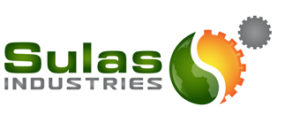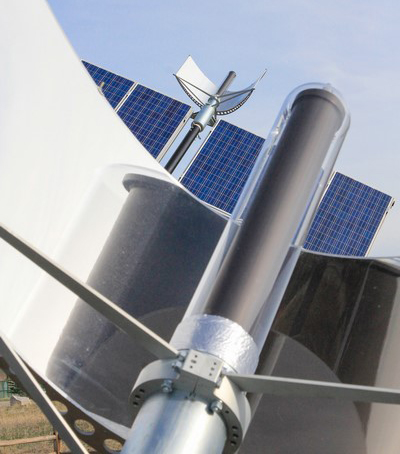Existing electronic single axis tracker systems suffer from a number of drawbacks, including high purchase, installation, maintenance and operating costs, complicated designs and reliability problems.
Sulas’ patented technology addresses these issues by replacing the entire drive and control mechanism with a much simpler and more cost-effective solution.
Drawing inspiration from Mother Nature – heliotropism, or the ability of flowers to follow the sun – the HelioDrive relies on three main components: a parabolic concentrator; a receiver filled with a small amount of engineered paraffin wax that acts as a hydraulic actuator; and a single moving component that translates linear travel into rotational motion, thereby generating a large amount of hydraulic force. As the sun rises and travels east to west, the mechanism automatically causes the connected solar panels to track the sun.
Paraffin wax, one of the key elements used in the HelioDrive, has been successfully used for more than a century to dependably and economically maintain equilibrium in closed loop systems. In fact, to this day paraffin wax continues to be used in automotive thermostats to maintain a steady engine temperature in even the most extreme environments. The paraffin wax used in the HelioDrive is inexpensive, extremely reliable and requires no maintenance, even over extended periods of time.
The HelioDrive operates in a diverse range of environments and conditions, from low desert heat to high mountain cold, and is capable of lifting over 3,000 pounds.

How Does a HelioDrive Work?
Remarkably, the HelioDrive has only one moving part,
and is powered entirely by the sun.
Operation of the HelioDrive
In the morning, the HelioDrive faces east at an angle of 45 degrees. When the sun rises sufficiently, the paraffin wax filled Receiver starts to collect heat. This causes the paraffin wax to heats and expand, which in turn forces the Piston inside the Receiver outward. The Piston pushes the Cam Tube, which has a helical cut that translates the linear motion into a rotational motion.
When the entire assembly rotates slightly west away from the sun, heat stops being applied to the Receiver, the paraffin wax stops expanding, and the system stops rotating west. The sun then “catches up,” moves back into the angle of acceptance of the system, causing the paraffin wax to continue heating and expanding and the assembly, once again, rotates slightly west. This incremental controlled movement repeats itself throughout the day.
Once the sun drops over the western horizon, the maximum travel of the system is reached and the paraffin wax cools, shrinks in volume, and allows the Piston to retract. Retraction back to east is achieved by gravity. The weight of the HelioDrive assembly as well as any device/racking/counter weight pulls the HelioDrive back down the helical cut in the Cam Tube to face east again.
At the end of the day, the PV array is again facing east to wait for the following day’s sunrise and repeat the cycle.
Another way to think about it is the sun is optically “pushing” the HelioDrive west. The HelioDrive actually never wants to be in the focus with the sun, every time the sun starts to focus its energy on the HelioDrive it wants to rotate west out of the way. This equilibrium of heat and mechanical movement is what drives the HelioDrive to not exactly “follow” the sun, but “stay in front” of the sun.
This is also why there is an offset angle between the HelioDrive and the solar array it is tracking. The HelioDrive has an angle of incidence of 2 hours or 30 degrees. Thus, the HelioDrive is always 15 degrees (half the angle of incidence) in “front” of the sun when in equilibrium and tracking. Therefore the solar panels and racking need to be 15 degrees “behind” the HelioDrive.
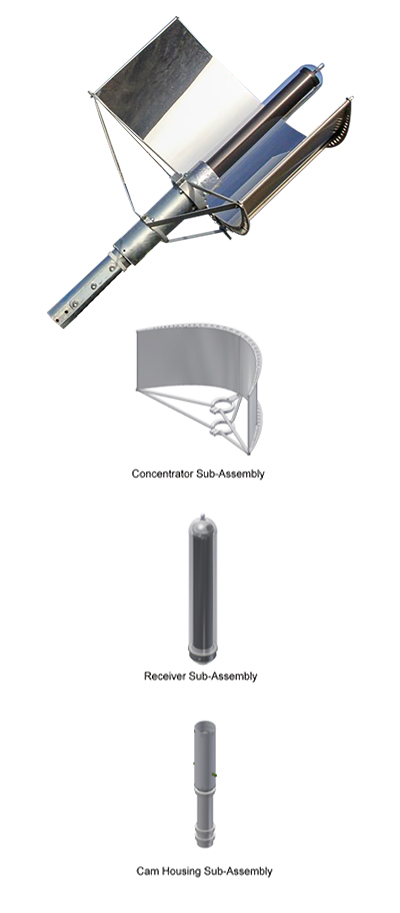
About Paraffin Wax Technology
NASA likes it.
Paraffin wax expands significantly when it phase changes from a solid to a liquid. This expansion can be harnessed into a hydrostatic force, much as water does when it phase changes to a solid and expands to heave entire buildings off their foundation.
Expanding paraffin wax is used in many applications. Currently, over a billion cars and trucks use paraffin wax-based thermostats to create equilibrium with the operating temperature of the engine. Using the expanding properties of paraffin wax, automotive thermostats regulate and maintain a steady temperature even in the extreme environments of varying temperatures, moisture and vibration inside the cooling system of a car engine. Paraffin-based thermostats are inexpensive, reliable, need no maintenance and have yet to be replaced with an electronic alternative.
 Other items like thermostatic mixing valves in home/building plumbing are paraffin wax-based. And NASA uses paraffin wax linear actuators in their space program as they are incredibly reliable and create a significant amount of power vs. an electrical linear actuator. All positive aspects that can be applied to solar tracking and the HelioDrive successfully capitalize on these benefits.
Other items like thermostatic mixing valves in home/building plumbing are paraffin wax-based. And NASA uses paraffin wax linear actuators in their space program as they are incredibly reliable and create a significant amount of power vs. an electrical linear actuator. All positive aspects that can be applied to solar tracking and the HelioDrive successfully capitalize on these benefits.
Cars using paraffin wax
based thermostats.
Foot-pounds of Torque HelioDrive
is Capable of Generating.
Approximate number of panels
in a ground-mount system a SINGLE
HelioDrive HD75 could turn.
(Configurations vary).
How Can HelioDrive be Used?
HelioDrive is configurable to many racking systems. A single unit can manage a large number of panels.
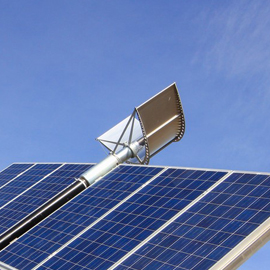
Top of Pole (TOP) Mount
When the HelioDrive is applied to a TOP system, it is essentially a direct drive attachment. The HelioDrive is directly coupled to the rotating assembly that is composed of racking and the solar panels themselves. So when the HelioDrive follows the sun, so does the rack and panels.
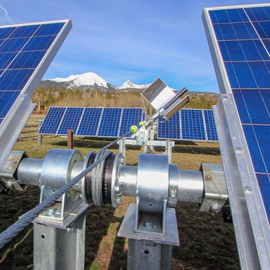
Ground Mount with Cable Drive
With a ground mount configuration HelioDrive is not directly couples to the array, but rather anchored on its own foundation and then a patent pending cable-based transmission system extends outward from the HelioDrive. This transmission system connects to multiple rows of horizontally ground mounted solar arrays.
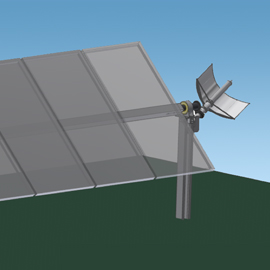
Ground Mount Direct Drive
A HelioDrive can be used to track a single row of horizontally ground mounted panels. In this configuration there is no cable coupling between rows, leaving space in between rows free of obstruction.
For More Information
We are Happy to to answer your questions and provide additional HelioDrive information on:
- Performance data
- Other capabilities
- Efficiency vs. Electronic Trackers
- Rack setup specs and details
- Power and capacity of different models
Or download our latest Data Sheet for the HelioDrive:
HelioDrive_Datasheet_2017
